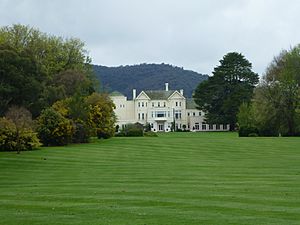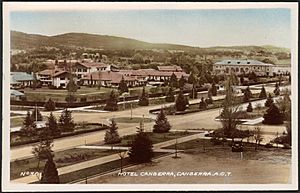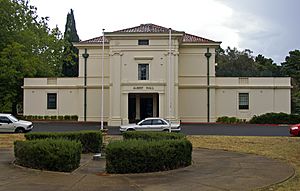List of buildings and structures in the Australian Capital Territory facts for kids
The Australian Capital Territory (ACT) is home to many important buildings and structures. These places are special because of their history, how they were built, or what they mean to Australia. This list helps us learn about these amazing buildings.
Different groups work to protect these important places. The National Heritage List includes places that are super important to all of Australia. The Commonwealth Heritage List protects buildings owned by the Australian Government. If a place is on one of these lists, it's against the law to damage it without permission.
There's also the Australian Capital Territory Heritage Register, which lists places important to the people of the ACT. These places help us understand the history and identity of the area. The National Trust of Australia also looks after several historic properties. Even though it doesn't have legal power, the Royal Australian Institute of Architects keeps a list of important 20th-century buildings, sharing information about their cool designs.
Contents
- Historic Buildings from the 1800s
- Important Buildings from the 1900s
- Pre-World War II Buildings: Early Canberra's Style
- Hotel Canberra: A Garden-Pavilion Design
- Old Parliament House: Where Laws Were Made
- The Lodge: Home of the Prime Minister
- Australian War Memorial: Remembering Heroes
- Kingston Powerhouse: Canberra's First Public Building
- Albert Hall: A Community Hub
- John Gorton Building: An Art Deco Landmark
- General Bridges' Grave: A Unique Memorial
- Yarralumla Brickworks: Building Canberra
- Post-World War II Buildings: Modern Designs Emerge
- Pre-World War II Buildings: Early Canberra's Style
Historic Buildings from the 1800s
Some of Canberra's oldest buildings were built long before it became the nation's capital. These structures give us a peek into what life was like in the 19th century.
St John's Anglican Church: Canberra's Oldest Public Building
Built in 1845, St John's Anglican Church in Reid is the oldest public building still standing in Canberra's city area. It was built almost 70 years before Canberra was even planned as the capital! Today, it's still an active church and a well-known landmark. You can also visit the Schoolhouse Museum nearby to see items from Canberra's early rural days.
Blundells Cottage: A Glimpse into Rural Life
Blundells Cottage was built in 1860 in Parkes. This five-room stone cottage is one of the few reminders of Canberra's farming past. It's now a museum, listed by the National Trust of Australia, where you can learn about the families who lived there.
Tharwa Bridge: Crossing the Murrumbidgee
The Tharwa Bridge, completed in 1895 in Tharwa, was the very first bridge built across the Murrumbidgee River. This special bridge, made with an "Allan truss" design, is still used by light traffic today. It's a great example of old engineering.
Yarralumla: Home to Australia's Governor-General
Built in 1891 by the Campbell family, Yarralumla in Yarralumla became the official home of the Governor-General of Australia in 1927. It's a very important building for Australia's government and is listed on the Commonwealth Heritage List.
Duntroon House: A Historic Estate
Duntroon House, built in 1833, is the oldest private building still standing in Canberra. It was also built by the Campbell family. Today, it serves as the officers' mess at the RMC Duntroon and is on the Commonwealth Heritage List.
Important Buildings from the 1900s
The 20th century saw Canberra grow from a planned city into a bustling capital, with many iconic buildings constructed during this time.
Pre-World War II Buildings: Early Canberra's Style
Many buildings from before World War II show the unique architectural styles of early Canberra.
Hotel Canberra: A Garden-Pavilion Design
The Hotel Canberra, built between 1922 and 1926 in Yarralumla, was designed by architect John Smith Murdoch. It features a beautiful Garden-Pavilion style, inspired by American and Australian designs. Today, it's operated by Hyatt and is open to the public.
Old Parliament House: Where Laws Were Made
Opened in 1927 in Parkes, Old Parliament House was where Australia's laws were made for many years. Now, it's a museum and also home to the National Portrait Gallery, allowing visitors to explore its history. It's on the Commonwealth Heritage List.
The Lodge: Home of the Prime Minister
The Lodge, built in 1927 in Deakin, is the official Canberra home for Australia's Prime Ministers. This two-storey brick building has a Colonial Revival style. It's listed on the Commonwealth Heritage List and sometimes has open days for the public.
Australian War Memorial: Remembering Heroes
The Australian War Memorial, completed in 1941 in Campbell, is a very important place. It honors Australians who have served and died in wars, conflicts, and peacekeeping operations. It's a powerful and moving place to visit.
Kingston Powerhouse: Canberra's First Public Building
The Kingston Powerhouse, built in 1915 in Kingston, was the first permanent public building in the ACT. Designed by John Smith Murdoch, it played a crucial role in providing power to early Canberra. It's now on the ACT Heritage Register.
Albert Hall: A Community Hub
Albert Hall, built in 1927 in Yarralumla, is a great example of the "Federal Style" architecture from early Canberra. It was designed by J H Kirkpatrick, R Casboulte, and H M Rolland. Today, it's a popular venue for events and is on the ACT Heritage Register.
John Gorton Building: An Art Deco Landmark
The John Gorton Building in Parkes is an Art Deco building with a long history. Construction started in 1927 but was stopped due to money issues. It was finally completed and opened in 1956. It's listed on the Commonwealth Heritage Register.
General Bridges' Grave: A Unique Memorial
The memorial grave of General Bridges, located at Royal Military College, Duntroon, was designed by the famous architect Walter Burley Griffin in 1920. It's a unique and historically significant site, listed on the Commonwealth Heritage List.
Yarralumla Brickworks: Building Canberra
The Yarralumla brickworks in Yarralumla were essential for building many of Canberra's early structures. They produced the bricks that shaped the new capital. While now closed to the public, they remain an important part of Canberra's industrial history.
Post-World War II Buildings: Modern Designs Emerge
After World War II, Canberra continued to grow, and new architectural styles, like Modernism and Brutalism, became popular.
Canberra Olympic Pool: A Modernist Design
The Canberra Olympic Pool, built between 1953 and 1955 in Civic, is a great example of Modernist architecture. Designed by Ian Slater, it was one of Australia's first public pools with a concrete diving tower. It even won an award, the Sulman Medal, in 1955. It's still open for everyone to enjoy.
The Shine Dome: A Unique Shape
The Shine Dome, completed in 1959 in Acton, is a truly unique building. Designed by Sir Roy Grounds, its dome shape is an example of "Geometric Structuralism." It houses the Australian Academy of Science and is occasionally open for public talks. It's also on the National Heritage List.
National Carillon: A Musical Gift
The National Carillon, built in 1970 in Parkes, is a tall tower with 57 bells. It was a gift from the British Government to celebrate Canberra's 50th anniversary. Designed by Cameron Chisholm Nicol, it's an example of the Brutalist style and is open to the public. It's also on the Commonwealth Heritage List.
High Court of Australia: A Landmark of Justice
The High Court of Australia building, completed between 1975 and 1980 in Parkes, is a significant landmark. Designed by Christopher Kringas, Edwards Madigan Torzillo and Briggs, it's where Australia's highest court makes important legal decisions. It's listed on the Commonwealth Heritage List.
National Gallery of Australia: Art for Everyone
The National Gallery of Australia, built from 1973 to 1982 in Parkes, Australian Capital Territory, is Australia's national art museum. Designed by Colin Madigan, it's made from reinforced concrete and houses an amazing collection of art. The gallery and its sculpture garden are open to the public and are on the Commonwealth Heritage List.
Edmund Barton Building: A Modern Design
The Edmund Barton Building, built from 1970 to 1974 in Barton, Australian Capital Territory, was designed by the famous architect Harry Seidler. It's a great example of the "Late Twentieth-Century International Style" and is one of the largest buildings of its kind in Canberra. It's listed on the Commonwealth Heritage List.
|





